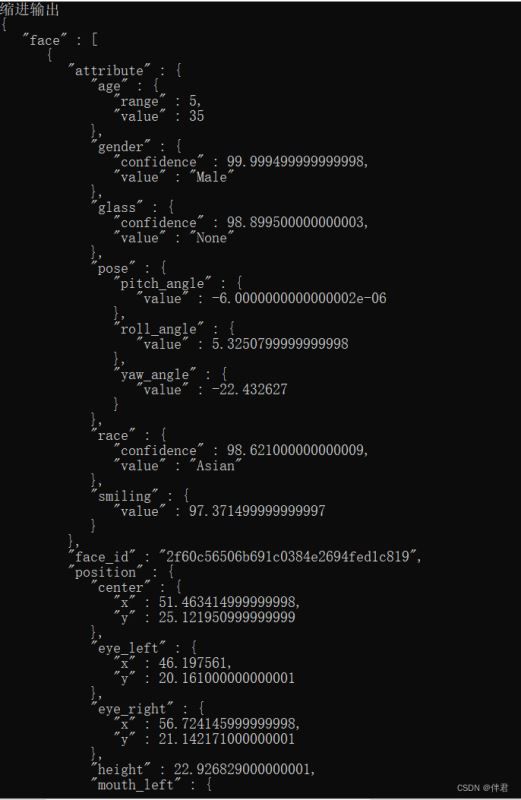1.JSON简介
1.1 什么是JSON:
JSON是一种纯字符串形式的数据,它本身不提供任何方法(函数),非常适合在网络中进行传输。JavaScript、PHP、Java、Python、C++等编程语言都内置了处理JSON数据的方法。
JSON 是基于 JavaScript(Standard ECMA-262 3rd Edition - December 1999)的一个子集,是一种开放的、轻量级的数据交换格式,采用独立于编程语言的文本格式来存储和表示数据,易于程序员阅读与编写,同时也易于计算机解析和生成,通常用于在 Web 客户端(浏览器)与 Web 服务器端之间传递数据。
在JSON中,使用一下两种方式表示数据:
- object(对象):键/值对(名称/值)的集合,使用花括号
{}定义。在每个键/值对中,以键开头,后跟一个冒号:,最后是值。多个键/值对之间使用逗号,分隔,例如"name":"FilterWindow","paramtype":"0"。 - Array(数组):值的有序集合,使用方括号
[]定义,数组中每个值之间使用逗号,进行分隔。
下面展示一个简单的JSON数据:
{
"name" : "FilterWindow",
"paramtype" : "0",
"range" :
{
"max" : 99,
"min" : 3
},
"required" : true,
"title" : "滤波窗口大小",
"type" : "int",
"value" : 51
"tempValue" :
[
"不生成" : 1,
"生成" : 0
],
}
1.2 JSON的优缺点:
优点:
相对于txt,word来说,json格式更加明确,获取重要信息非常方便。
相对于xml来说,json格式更加简洁,存储同样的文件,花费的内存更小。
相对于Excel来说,json更适合存储字符类文件。Excel相当于比较简单的数据库了。
相对于数据库来说,json更加方便,数据库我们还需要做一些设置,安装一些软件。json可以直接使用。
缺点:
只有一种数字类型:JSON中只能支持IEEE-754双精度浮点格式,因此我们无法使用JSON来存储许多编程语言中多样化的数字类型;
没有日期类型:在JSON中我们只能通过日期的字符串(例如:1970-01-01)或者时间戳(例如:1632366361)来表示日期;
没有注释:在JSON中无法添加注释;
冗长:虽然JSON比XML更加简洁,但它不是最简洁的数据交换格式,对于数据量庞大或用途特殊的服务,我们需要更加高效的数据格式。
1.3 JSON的存储:
JSON数据可以存储在.json格式的文件中(与.txt格式类似,都属于纯文本文件),也可以将JSON数据以字符串的形式存储在数据库、Cookie、Session中。要使用存储好的JSON数据也非常简单,不同的编程语言中提供了不同的方法来检索和解析JSON数据,今天我们的重点就是使用C++来操作.json文件。而C++主要使用jsoncpp这个跨平台的开源库来实现对.json文件的各类操作。
2.jsoncpp库介绍
2.1 jsoncpp库的配置使用:
这里我就不按照网上常规的方式来介绍了,常规的方法无非是关于下载jsoncpp库,然后使用Windows编译(vs2015),最后整理出include及lib来使用jsoncpp库。我这里是整理好的,是直接把include里的所有文件集合成json.h以及json.cpp。用的时候直接把这些文件包含进自己的项目一起编译即可。
2.2 jsoncpp库内部构成:
jsoncpp主要包含三个class(类):Value、Reader、Writer。注意Json::Value只能处理ANSI类型的字符串,如果C++程序是用Unicode编码的,最好加一个Adapt类来适配。
Value: 是jsoncpp中最基本、最重要的类,用于表示各种类型的对象,jsoncpp支持的对象类型可见下面的Json::ValueType枚举值;Value类的对象代表一个JSON,既可以代表一个文档,也可以代表文档中一个值。如同JSON中定义的“值”一样,Value是递归的。
enum ValueType
{
nullValue = 0, ///< 'null' value
intValue, ///< signed integer value
uintValue, ///< unsigned integer value
realValue, ///< double value
stringValue, ///< UTF-8 string value
booleanValue, ///< bool value
arrayValue, ///< array value (ordered list)
objectValue ///< object value (collection of name/value pairs).
};
Value类里的函数如下所示:
1、【构造函数】 Value( ValueType type = nullValue ); Value( Int value ); Value( UInt value ); Value( double value ); Value( const char *value ); Value( const char *beginValue, const char *endValue ); 2、【拷贝构造函数】 Value( const StaticString &value ); Value( const std::string &value ); Value( const Value &other ); 3、【相同类型的比较、交换、类型的获取】 void swap( Value &other ); ValueType type() const; int compare( const Value &other ); 4、【相应的赋值运算符的重载函数】 Value &operator=( const Value &other ); bool operator <( const Value &other ) const; bool operator <=( const Value &other ) const; bool operator >=( const Value &other ) const; bool operator >( const Value &other ) const; bool operator ==( const Value &other ) const; bool operator !=( const Value &other ) const; bool operator!() const; Value &operator[]( UInt index ); const Value &operator[]( UInt index ) const; 5、【将Value对象进行相应的类型转换】 const char *asCString() const; std::string asString() const; const char *asCString() const; std::string asString() const; Int asInt() const; UInt asUInt() const; double asDouble() const; 6、【相应的判断函数】 bool isNull() const; bool isBool() const; bool isInt() const; bool isUInt() const; bool isIntegral() const; bool isDouble() const; bool isNumeric() const; bool isString() const; bool isArray() const; bool isObject() const; bool isConvertibleTo( ValueType other ) const; bool isValidIndex( UInt index ) const; bool isMember( const char *key ) const; bool isMember( const std::string &key ) const; 7、【清除和扩容函数】 void clear(); void resize( UInt size ); 8、【获取满足相应条件的Value】 Value get( UInt index, const Value &defaultValue ) const; Value get( const std::string &key,const Value &defaultValue ) const; Members getMemberNames() const; 9、【删除满足相应条件的Value】 Value removeMember( const char* key ); Value removeMember( const std::string &key ); 10、【】 void setComment( const char *comment,CommentPlacement placement ); void setComment( const std::string &comment,CommentPlacement placement ); bool hasComment( CommentPlacement placement ) const; std::string getComment( CommentPlacement placement ) const; std::string toStyledString()const;
Reader :是用于读取的,确切说是用于将字符串转换为Json::Value对象的。
1、【构造函数】 Reader(); 2、【拷贝构造函数】 Reader( const Features &features ); 3、【将字符串或者输入流转换为JSON的Value对象】【下边是相应的parse的重载函数】 bool parse( const std::string &document, Value &root,bool collectComments = true ); bool parse(const char *beginDoc, const char *endDoc, Value &root,bool collectComments = true) bool parse( std::istream &is,Value &root,bool collectComments = true ); 4、【】 std::string getFormatedErrorMessages() const;
Writer :是一个纯虚类,并不能直接使用。在此我们使用Json::Writer的子类(派生类):Json::FastWriter、Json::StyledWriter、Json::StyledStreamWriter。顾名思义,用Json::FastWriter来处理json应该是最快的;负责将内存中的Value对象转换成JSON文档,输出到文件或者字符串中。
1、【FastWriter】
FastWriter();
virtual ~FastWriter(){}
void enableYAMLCompatibility();
virtual std::string write( const Value &root );
2、【StyledWriter】
StyledWriter();
virtual ~StyledWriter(){}
virtual std::string write( const Value &root );
3.json文件读取(例)
3.1 json文件:
{
"face": [
{
"attribute": {
"age": {
"range": 5,
"value": 35
},
"gender": {
"confidence": 99.9995,
"value": "Male"
},
"glass": {
"confidence": 98.8995,
"value": "None"
},
"pose": {
"pitch_angle": {
"value": -0.000006
},
"roll_angle": {
"value": 5.32508
},
"yaw_angle": {
"value": -22.432627
}
},
"race": {
"confidence": 98.62100000000001,
"value": "Asian"
},
"smiling": {
"value": 97.3715
}
},
"face_id": "2f60c56506b691c0384e2694fed1c819",
"position": {
"center": {
"x": 51.463415,
"y": 25.121951
},
"eye_left": {
"x": 46.197561,
"y": 20.161
},
"eye_right": {
"x": 56.724146,
"y": 21.142171
},
"height": 22.926829,
"mouth_left": {
"x": 45.610732,
"y": 30.399024
},
"mouth_right": {
"x": 56.01561,
"y": 31.734146
},
"nose": {
"x": 49.063659,
"y": 27.171951
},
"width": 22.926829
},
"tag": ""
}
],
"img_height": 410,
"img_id": "84c20011223acd4efa0b5aa13fc2146d",
"img_width": 410,
"session_id": "42c5db376fdc4da9855d0135b5e414e2",
"url": "http://www.faceplusplus.com.cn/wp-content/themes/faceplusplus/assets/img/demo/16.jpg?v=2"
}
3.2 源码:
#include#include #include #include "json.h" using namespace std; int main() { Json::Reader reader; Json::Value root; ifstream is; is.open("face.json", ios::binary); if (reader.parse(is, root)) { Json::StyledWriter sw; //缩进输出 cout << "缩进输出" << endl; cout << sw.write(root) << endl << endl; } return 0; }
3.3 结果图:
总结
到此这篇关于C++操作.json文件的文章就介绍到这了,更多相关C++操作.json文件内容请搜索脚本之家以前的文章或继续浏览下面的相关文章希望大家以后多多支持脚本之家!

